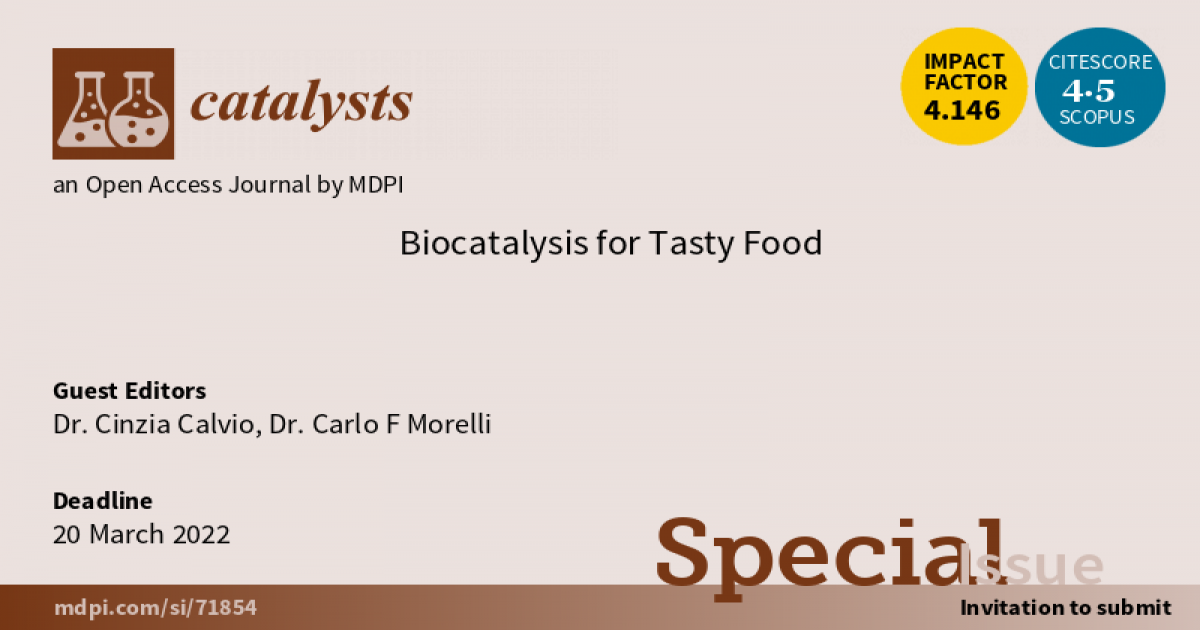- 4.0Impact Factor
- 7.6CiteScore
- 16 daysTime to First Decision
Biocatalysis for Tasty Food
This special issue belongs to the section “Biocatalysis“.
Special Issue Information
Dear Colleagues,
The production of new flavor enhancers and aroma compounds is a topic of paramount interest in the food industry, as they ensure product homogeneity, favorable consumer acceptance, and can support programs aimed at reducing salt and fat intake. The exposure of consumers to new flavors, as a consequence of the growth of the ethnic food sector with consequent changes in consumers’ lifestyle, and concerns about some of the flavor enhancers currently in use, boosts the search for highly acceptable, possibly naturally occurring, alternatives. Biocatalytic methods may offer a viable, sustainable, and convenient entry to these products, particularly with compounds of biotechnological origin, or the use of waste by-products from other processes’ streams as raw material.
We are pleased to invite you to submit original research papers, short communications, letters, or review articles focused on the biocatalyzed synthesis of taste-active compounds, aroma compounds, flavor enhancers, or food additives aimed at improving food acceptance and/or organoleptic properties.
Dr. Cinzia Calvio
Dr. Carlo F Morelli
Guest Editors
Manuscript Submission Information
Manuscripts should be submitted online at www.mdpi.com by registering and logging in to this website. Once you are registered, click here to go to the submission form. Manuscripts can be submitted until the deadline. All submissions that pass pre-check are peer-reviewed. Accepted papers will be published continuously in the journal (as soon as accepted) and will be listed together on the special issue website. Research articles, review articles as well as short communications are invited. For planned papers, a title and short abstract (about 250 words) can be sent to the Editorial Office for assessment.
Submitted manuscripts should not have been published previously, nor be under consideration for publication elsewhere (except conference proceedings papers). All manuscripts are thoroughly refereed through a single-blind peer-review process. A guide for authors and other relevant information for submission of manuscripts is available on the Instructions for Authors page. Catalysts is an international peer-reviewed open access monthly journal published by MDPI.
Please visit the Instructions for Authors page before submitting a manuscript. The Article Processing Charge (APC) for publication in this open access journal is 2200 CHF (Swiss Francs). Submitted papers should be well formatted and use good English. Authors may use MDPI's English editing service prior to publication or during author revisions.
Keywords
- Taste-active compounds
- Flavor enhancers
- Aroma compounds
- Umami
- Kokumi
- Food industry
- Enzyme
- Biocatalysis
- Biocatalyzed synthesis
- Enzyme modification
- Immobilized enzymes

Benefits of Publishing in a Special Issue
- Ease of navigation: Grouping papers by topic helps scholars navigate broad scope journals more efficiently.
- Greater discoverability: Special Issues support the reach and impact of scientific research. Articles in Special Issues are more discoverable and cited more frequently.
- Expansion of research network: Special Issues facilitate connections among authors, fostering scientific collaborations.
- External promotion: Articles in Special Issues are often promoted through the journal's social media, increasing their visibility.
- e-Book format: Special Issues with more than 10 articles can be published as dedicated e-books, ensuring wide and rapid dissemination.

